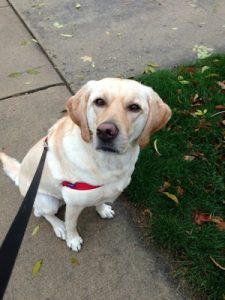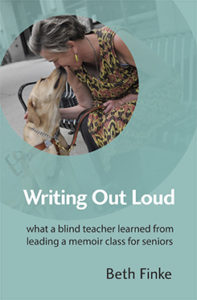It seems like only yesterday: Beth’s Seeing Eye dog Harper saved them both from being run over at an intersection a couple blocks from home. Harper yanked Beth out of harm’s way—so hard that she fell to the pavement and that the sturdy metal harness snapped. It was a harrowing experience, but afterward Beth and Harper went about their business normally.

First there was Dora (she’s the one with the antlers). Photo by Lois Haubold.
Until.
One day Harper stopped cold on the sidewalk in the middle of Chicago’s Loop. Beth cajoled him into getting her home. But things only got worse. Harper would cower and shake, and more than once I had to drive the car to pick them up because he wouldn’t move. After The Seeing Eye had sent four different trainers out to try to remedy the situation, a representative told Beth, “He took a bullet for you, and he’s earned an early retirement.”
Indeed he had. And he’s been living happily ever after with our friends Chris and Larry.

Then there was Hanni.
And we’ve been living happily with Whitney, an intrepid traveler who’s behaved impeccably on planes, trains, and automobiles, sat quietly during plays and concerts, and kept herself and Beth safe in the midst of the chaos of Chicago’s downtown traffic.
These days she walks slower when leading Beth. She sleeps more than she used to. Sometimes she balks at commands and Beth has to out-stubborn her. And, instead of unfailingly and relentlessly retrieving her yellow lacrosse ball for me to throw it again (and again), she retrieves it, lays down on the rug, and shows it to me.
Whitney’s been at it for over seven years, and it’s time. She’s earned her retirement. Beth’s other dogs have worked longer. Dora worked until she was 12. Hanni worked until she was 11. But both of them spent all or part of there tenure in quieter, saner, Champaign-Urbana. Urban life is harder on dogs.

Then the heroic Harper, here hangin’ in his new civilian harness.
Whitney will turn 10 this December, and it’s likely she’ll celebrate it at Beth’s great niece’s house in Minneapolis—Shelley Rae has generously offered to adopt her when she retires. Beth’s other two retired dogs both lived until 17, so we’re hoping Whitney gets a lot of time just hanging out in the Twin Cities. She’s earned it.
For Beth and me, it’s a very hard conclusion to come to. I fall hopelessly in love with every damned dog Beth brings home from The Seeing Eye, and I miss them when they retire and move away. For Beth, though, it’s a real hardship. She travels to The Seeing Eye in New Jersey sans her longtime companion, and spends three weeks in a dorm after being matched with her new partner.
Besides all the schedule juggling to accommodate the training, it’s just hard work. Beth’s up at 5:00 a.m. every day, and every day is full of training on the streets of Morristown, New Jersey, with side trips to New York City, plus lectures about what’s new since students were there last.
That’s just the start. Once at home, the new dog has to learn the minutiae of Beth’s life. Like finding Beth’s locker at the pool where she swims laps. Getting her to ticket counters and moving up in the line. In and out of cabs, buses, and trains. Turnstiles at the L.

Whitney’s graduation picture. (Courtesy The Seeing Eye.) I wonder who’s next?
For months after coming home, the dog has to be with Beth constantly—that means we go nowhere without the dog. I know some of you envy the ability to bring your dog everywhere. Trust me. You don’t want to trade places with Beth.
Here’s the thing: The person and the dog really do bond as a team. They have to get to know one another. They have to come to implicitly trust one another. Sure, it’s obvious how reliant Beth is on the dog—but the dog trusts the human to get directions correct, to make good decisions.
That trust takes time. Really, the two are in training for months after leaving The Seeing Eye.
And then they settle in. That’s when we find out what each dog is really good at, and what they’re not so good at, over time. Whitney is really good at:
- Finding elevator buttons not just at our building, but everywhere there are elevators.
- Not having to pee or poop for inordinately long periods of time. I’m envious.
- Having an uncanny ability to slow down at just the right time to clue Beth in that there is an irregularity in the pavement that could be trouble. Beth knows to walk accordingly.
- Going down the stairs at the subway. You’d be surprised how hard that is for the dog; ordinarily they’d bound down multiple steps but they have to creep one at a time on their four legs.
- Weaving through crowds without bumping Beth into anyone.
- Being calm in the face of everything that’s been thrown at her.
- Entertaining me with the lacrosse ball.
On the other hand:
- She’s never met a pole she didn’t want to sniff.
- She rarely sees another dog she doesn’t want to meet.
On balance, she has been—like Beth’s other companions—nothing short of wondrous.
But it’s not magic. Breeding, training, hard work (under half the candidate dogs make the cut)—all that before being matched with a person and headed to a new home.

OK, one more. Beth’s great niece Kennedy (aka “Toots”) and Whitney took to one another right away.
Having seen this process up close, I must confess to utter disappointment when people who don’t really need a dog to do basic activities bring their untrained dogs into public spaces. But that’s for another day.
Beth has put in her application at The Seeing Eye. Between now and the end of this year, we expect she’ll be shipping out again, and I’ll be bacheloring it for a few weeks, waiting for Beth to come home with my new favorite.








